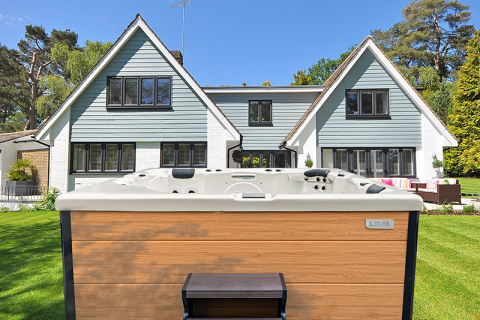
- Home
- >
News
As a leading supplier of outdoor hot tubs and swim spas, Lovia Spa ensures excellence through advanced manufacturing technology and strict quality control. Our factory supports wholesale pricing, bulk discounts, and customized orders to fit the needs of businesses and distributors worldwide.
Most outdoor hot tub covers have a very limited weight capacity, usually between 50 and 100 pounds (about 23 to 45 kilograms). This means that they can withstand some minor pressure, such as the weight of leaves, snow or rain, but are not suitable for adults or heavy objects to sit directly on them.
After a day of work and life pressure, the night is the time for most people to relax. The outdoor hot tub itself can help relax muscles and soothe tense nerves through hot water and massage functions, and the quietness and privacy of the night make this relaxation effect more significant.
Hot tub shock treatment is characterized by rapidity and efficiency, and is usually carried out when there are signs of deterioration in water quality. Even users who use chemical disinfectants (such as chlorine or bromine) or are equipped with ozone generators on a daily basis need to perform shock treatment regularly.
While hot tub massage jets are designed to run for long periods of time, they are not usually designed to work around the clock. Long-term operation will cause greater loads on the pump, motor, and filtration system, so leaving it on overnight may affect the life of the device.
Heating efficiency is one of the most important factors that users are concerned about when heating a hot tub. When the jet is running, it can indeed help to distribute heat more evenly in the water by accelerating the water flow and promoting water agitation.
Since the hot tub heater is directly involved in the heating and circulation of water, it inevitably involves the water in the bathtub when replacing the heater. The replacement operation of the hot bathtub heater requires disconnecting the water pump and the pipe system, which usually means that the water needs to be drained to prevent water from overflowing or leaking during the operation.
The low temperature environment in winter poses many challenges to the operation of outdoor hot tubs, the most obvious of which is the rapid loss of water temperature and the potential risk of equipment damage. Therefore, covering the hot tub has become a key measure to protect the equipment and save energy.
After adjusting the outdoor hot tub alkalinity, users need to give the water quality a certain amount of time to stabilize. Generally, you should wait at least 4 to 6 hours after adjusting the hot tub alkalinity before adjusting the pH. This is because when adding chemicals to adjust the alkalinity, the chemical reaction in the water takes a certain amount of time to complete.
The growth of algae is often accompanied by changes in the chemical composition of the hot tub water, such as increased hot bathtub pH and turbidity. Contact with water containing algae may cause discomfort to the eyes and respiratory tract, especially when other harmful microorganisms are present in the water.
The maintenance of the ozone generator is relatively simple. Once installed, it is usually only necessary to regularly check the operation of the ozone generator and perform necessary cleaning and maintenance. Because ozone can reduce the use of other chemicals, ozone systems perform well in reducing chemical residues and maintaining water quality.
When shocking, especially when using non-chlorine shocking agents (such as potassium persulfate), the shocking agent converts bromineamines back to hypobromous acid through oxidation. This process does not increase the actual bromine content in the water, but it does increase the concentration of active bromine.












